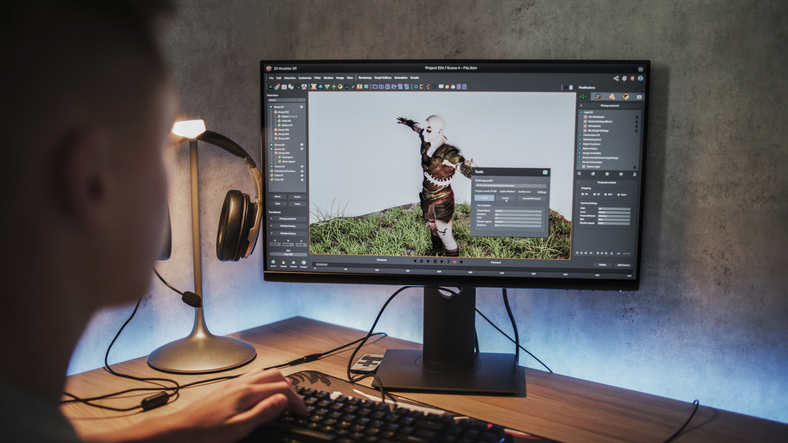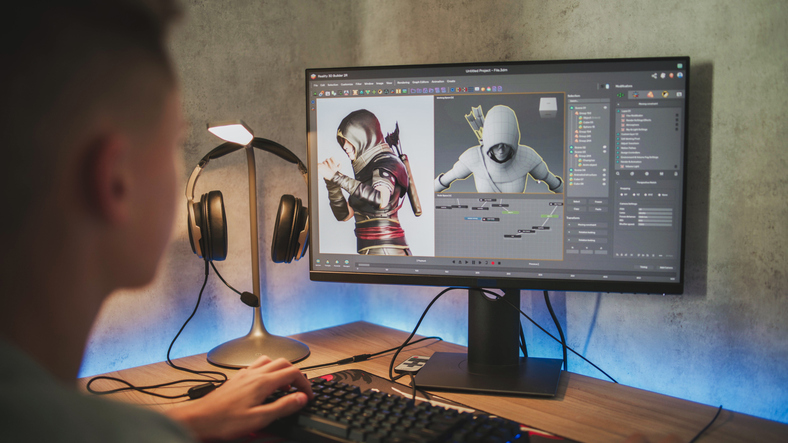Are you passionate about creativity and visual storytelling but wondering if you need a degree to become a graphic designer? The good news is no, a traditional four-year degree is not required to enter the field of graphic design. Many successful designers have built their careers without ever stepping foot in a university classroom.
However, while a degree isn’t necessary, structured education can be incredibly beneficial. Enrolling in a diploma program, such as VCAD’s Graphic Design Diploma Program, can fast-track your learning, provide hands-on training, and help you graduate with an impressive portfolio that makes you stand out in the job market.
So, what are your options? In this article, we’ll explore the role of a graphic designer, compare different educational paths, and highlight why VCAD’s Graphic Design Diploma Program is a better alternative for aspiring designers who want to gain real-world skills and enter the industry quickly.
Understanding the Role of a Graphic Designer
Graphic design is a dynamic and creative field that plays a crucial role in modern visual communication. Whether we realize it or not, graphic design is all around us—from the logos of our favorite brands to the user interfaces of the apps we use daily. Graphic designers are visual communicators who use creativity, artistic skills, and technology to bring ideas to life through images, typography, and layout design. Their work is essential in industries ranging from marketing and advertising to web development and product packaging.
Definition of Graphic Design
At its core, graphic design is the practice of creating visual content to communicate messages effectively. It involves combining elements such as typography, images, colors, and layout principles to convey specific ideas in a way that resonates with audiences. Graphic design is not just about making things look aesthetically pleasing it’s about solving problems through visual storytelling and ensuring that designs serve a clear function.
Graphic designers bridge the gap between creativity and strategy, ensuring that their work aligns with a brand’s goals, marketing efforts, and user experience. Some of the key responsibilities of a graphic designer include:
Graphic design is an ever-evolving field that combines creativity with technical skills. While talent plays a big role, structured training can help you develop the skills you need to thrive in the industry.
The Traditional Path: Pursuing a Degree in Graphic Design
Many people assume that a university degree is the only way to become a professional graphic designer. While a Bachelor’s degree in Graphic Design can offer benefits, such as in-depth theoretical knowledge and networking opportunities, it also has some major drawbacks:
For students who want a faster, more affordable, and career-focused path into graphic design, a diploma program is a much better option.
Alternative Paths to Becoming a Graphic Designer
If a university degree isn’t necessary, what are the best ways to learn graphic design? Many aspiring designers take alternative routes, including:
1. Self-Teaching
Many graphic designers start by teaching themselves using free resources such as YouTube tutorials, blogs, and online communities. With a wealth of information available online, self-teaching allows for a flexible and cost-effective way to learn graphic design.
Pros of Self-Teaching:
✔ Free or Low-Cost Learning: There are countless free tutorials and affordable online courses available.
✔ Learn at Your Own Pace: No deadlines or rigid schedules—study whenever it’s convenient.
✔ Explore Your Interests: You can focus on specific areas of design that interest you the most.
Cons of Self-Teaching:
✘ Lack of Structure: Without a guided curriculum, it can be overwhelming to figure out what to learn and in what order.
✘ No Industry Guidance: You miss out on mentorship and feedback from experienced designers.
✘ No Formal Certification or Portfolio Support: Many job postings require a portfolio, and self-learners may struggle to create a polished portfolio without structured projects.
Who is self-teaching best for?
Self-teaching is best for highly motivated individuals who enjoy independent learning and can stay disciplined without external guidance. However, for those who need a clear roadmap, mentorship, and industry connections, a more structured option may be better.
2. Short Online Courses & Bootcamps
There are various short-term online courses and bootcamps designed to teach specific aspects of graphic design. These programs often focus on one skill at a time, such as UI/UX design, branding, or Adobe Creative Suite.
Pros of Online Courses & Bootcamps:
✔ Fast-Track Learning: Short courses provide intensive, focused training in a short period.
✔ Flexibility: Many courses allow you to learn from anywhere at your own convenience.
✔ Exposure to Industry Experts: Some bootcamps offer access to professionals who provide feedback.
Cons of Online Courses & Bootcamps:
✘ Limited Depth: Short-term programs don’t always provide comprehensive training in all areas of graphic design.
✘ No Hands-On Experience: Many online courses lack project-based learning, which is essential for building a portfolio.
✘ No Job Support or Career Guidance: Unlike structured programs, most bootcamps don’t offer job placement assistance or long-term mentorship.
Who are short online courses & bootcamps best for?
Short courses are great for those looking to enhance a specific skill or upskill quickly. However, they may not be the best choice for beginners looking to build a full-fledged graphic design career.
3. Diploma Programs – The Best of Both Worlds
For students who want a structured learning environment, hands-on experience, and portfolio development, a graphic design diploma program is the ideal option. Diploma programs offer a balance between self-learning flexibility and the structured education of a degree, making them one of the best paths for launching a successful career.
Pros of a Graphic Design Diploma Program
✔ Comprehensive & Hands-On Training: Unlike short courses, diploma programs cover everything you need to succeed in the industry—including branding, typography, UI/UX, and marketing design.
✔ Portfolio Development: Every student graduates with an impressive, industry-ready portfolio, which is critical for job applications.
✔ Industry Mentorship: Learn from seasoned professionals who provide valuable feedback, helping you refine your skills.
✔ Faster Than a University Degree: Unlike a four-year degree, diploma programs can be completed in a much shorter time, allowing students to enter the workforce quickly.
✔ Job Placement Support: Many diploma programs, such as VCAD’s Graphic Design Diploma Program, offer career assistance and job placement services.
✔ A Recognized Credential: While not as time-consuming as a degree, a diploma still provides a valuable qualification that can strengthen your resume.
Cons of a Graphic Design Diploma Program
✘ More Investment Than Free Resources: But you receive expert guidance, structured learning, and career support—things you don’t get with self-teaching.
✘ Time Commitment Required → However, it’s still significantly shorter than a traditional university degree, allowing you to start working faster.
✘ More Focused on Practical Skills → Unlike degrees, which focus on theory, diploma programs emphasize real-world applications—which is what employers actually look for!
Who is a diploma program best for?
A graphic design diploma program is perfect for students who want job-ready skills, structured learning, mentorship, and a strong portfolio without the long-time commitment or high costs of a university degree.
Essential Skills Every Graphic Designer Needs
Regardless of the education path you choose, every graphic designer must master certain skills to be successful:
1. Technical Skills
2. Creativity & Problem-Solving
3. Soft Skills
Learning these skills on your own can be challenging, which is why a structured diploma program is the best way to gain hands-on experience and develop your portfolio.
Why VCAD’s Graphic Design Diploma Program is a Better Option
If you’re serious about starting a career in graphic design, a structured diploma program will give you the skills and experience you need—without the time and financial burden of a degree.
1. Hands-On, Career-Focused Training
At VCAD, students learn by doing. The program is designed to teach real-world design skills, focusing on industry-standard software, design principles, and practical projects.
2. Build a Professional Portfolio
Employers care more about your portfolio than your degree. VCAD’s Graphic Design Diploma Program ensures that every student graduates with an impressive portfolio showcasing their best work. This makes job applications and freelance opportunities much easier to secure.
3. Learn from Industry Experts
Students at VCAD are mentored by experienced industry professionals who provide valuable insights, feedback, and career guidance.
4. Faster and More Affordable than a University Degree
Instead of spending four years at university, VCAD’s diploma program can be completed in a much shorter time, helping students enter the workforce quickly. Additionally, tuition fees are significantly more affordable compared to traditional degrees.
5. Career Support & Job Placement Assistance
VCAD provides job placement assistance, helping graduates find internships and job opportunities in the industry. The connections and industry exposure gained during the program give students a competitive edge.
For students looking for the best path into graphic design, VCAD’s Graphic Design Diploma Program is the perfect choice.
Job Market Perspective: Do Employers Require a Degree?
Many aspiring designers worry that employers only hire candidates with degrees—but this isn’t true. Most companies prioritize skills and portfolio quality over formal education.
What Employers Look for in a Graphic Designer:
✔ Strong portfolio showcasing diverse work
✔ Proficiency in design software (Adobe Creative Suite, Figma, etc.)
✔ Real-world experience (internships, freelance projects)
✔ Ability to solve design problems creatively
✔ Strong communication and collaboration skills
Many leading companies, startups, and design agencies now hire designers based on their skills and portfolio, rather than focusing on a degree. This means that graduates of diploma programs like VCAD’s Graphic Design Diploma have an equal (if not better) chance of getting hired.
Final Thoughts
So, do you need a degree to become a graphic designer? The answer is clear: No, you don’t.
However, structured learning and hands-on training can help you gain the skills, confidence, and portfolio needed to succeed. Rather than investing four years in a university degree, a graphic design diploma program—such as the one offered by VCAD provides a faster, more practical, and affordable way to enter the industry.
If you’re passionate about design and ready to start your creative career, VCAD’s Graphic Design Diploma Program is the perfect place to begin.
Start Your Journey Today!
Interested in learning more about VCAD’s Graphic Design Diploma Program? Contact us today to find out how you can fast-track your career in graphic design!














